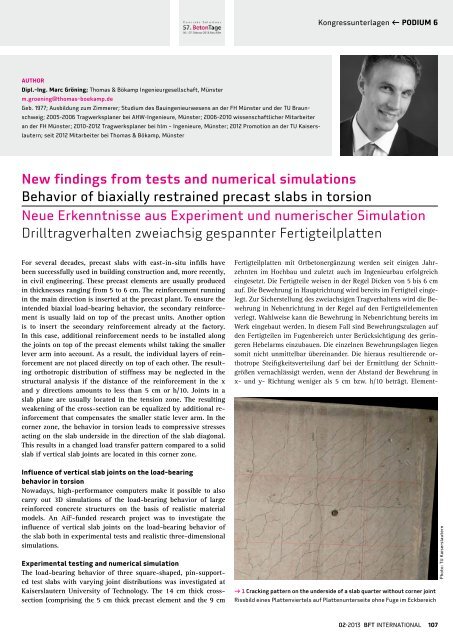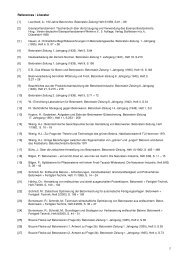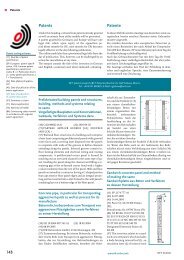KONGRESSUNTERLAGEN | PROCEEDINGS - Bft-international.com
KONGRESSUNTERLAGEN | PROCEEDINGS - Bft-international.com
KONGRESSUNTERLAGEN | PROCEEDINGS - Bft-international.com
Erfolgreiche ePaper selbst erstellen
Machen Sie aus Ihren PDF Publikationen ein blätterbares Flipbook mit unserer einzigartigen Google optimierten e-Paper Software.
Kongressunterlagen ← PODIUM 6<br />
AUTHOR<br />
Dipl.-Ing. Marc Gröning; Thomas & Bökamp Ingenieurgesellschaft, Münster<br />
m.groening@thomas-boekamp.de<br />
Geb. 1977; Ausbildung zum Zimmerer; Studium des Bauingenieurwesens an der FH Münster und der TU Braunschweig;<br />
2005-2006 Tragwerksplaner bei AHW-Ingenieure, Münster; 2006-2010 wissenschaftlicher Mitarbeiter<br />
an der FH Münster; 2010-2012 Tragwerksplaner bei hlm – Ingenieure, Münster; 2012 Promotion an der TU Kaiserslautern;<br />
seit 2012 Mitarbeiter bei Thomas & Bökamp, Münster<br />
New findings from tests and numerical simulations<br />
Behavior of biaxially restrained precast slabs in torsion<br />
Neue Erkenntnisse aus Experiment und numerischer Simulation<br />
Drilltragverhalten zweiachsig gespannter Fertigteilplatten<br />
For several decades, precast slabs with cast-in-situ infills have<br />
been successfully used in building construction and, more recently,<br />
in civil engineering. These precast elements are usually produced<br />
in thicknesses ranging from 5 to 6 cm. The reinforcement running<br />
in the main direction is inserted at the precast plant. To ensure the<br />
intended biaxial load-bearing behavior, the secondary reinforcement<br />
is usually laid on top of the precast units. Another option<br />
is to insert the secondary reinforcement already at the factory.<br />
In this case, additional reinforcement needs to be installed along<br />
the joints on top of the precast elements whilst taking the smaller<br />
lever arm into account. As a result, the individual layers of reinforcement<br />
are not placed directly on top of each other. The resulting<br />
orthotropic distribution of stiffness may be neglected in the<br />
structural analysis if the distance of the reinforcement in the x<br />
and y directions amounts to less than 5 cm or h/10. Joints in a<br />
slab plane are usually located in the tension zone. The resulting<br />
weakening of the cross-section can be equalized by additional reinforcement<br />
that <strong>com</strong>pensates the smaller static lever arm. In the<br />
corner zone, the behavior in torsion leads to <strong>com</strong>pressive stresses<br />
acting on the slab underside in the direction of the slab diagonal.<br />
This results in a changed load transfer pattern <strong>com</strong>pared to a solid<br />
slab if vertical slab joints are located in this corner zone.<br />
Fertigteilplatten mit Ortbetonergänzung werden seit einigen Jahrzehnten<br />
im Hochbau und zuletzt auch im Ingenieurbau erfolgreich<br />
eingesetzt. Die Fertigteile weisen in der Regel Dicken von 5 bis 6 cm<br />
auf. Die Bewehrung in Hauptrichtung wird bereits im Fertigteil eingelegt.<br />
Zur Sicherstellung des zweiachsigen Tragverhaltens wird die Bewehrung<br />
in Nebenrichtung in der Regel auf den Fertigteilelementen<br />
verlegt. Wahlweise kann die Bewehrung in Nebenrichtung bereits im<br />
Werk eingebaut werden. In diesem Fall sind Bewehrungszulagen auf<br />
den Fertigteilen im Fugenbereich unter Berücksichtigung des geringeren<br />
Hebelarms einzubauen. Die einzelnen Bewehrungslagen liegen<br />
somit nicht unmittelbar übereinander. Die hieraus resultierende orthotrope<br />
Steifigkeitsverteilung darf bei der Ermittlung der Schnittgrößen<br />
vernachlässigt werden, wenn der Abstand der Bewehrung in<br />
x- und y- Richtung weniger als 5 cm bzw. h/10 beträgt. Element-<br />
Influence of vertical slab joints on the load-bearing<br />
behavior in torsion<br />
Nowadays, high-performance <strong>com</strong>puters make it possible to also<br />
carry out 3D simulations of the load-bearing behavior of large<br />
reinforced concrete structures on the basis of realistic material<br />
models. An AiF-funded research project was to investigate the<br />
influence of vertical slab joints on the load-bearing behavior of<br />
the slab both in experimental tests and realistic three-dimensional<br />
simulations.<br />
Experimental testing and numerical simulation<br />
The load-bearing behavior of three square-shaped, pin-supported<br />
test slabs with varying joint distributions was investigated at<br />
Kaiserslautern University of Technology. The 14 cm thick crosssection<br />
(<strong>com</strong>prising the 5 cm thick precast element and the 9 cm<br />
→ 1 Cracking pattern on the underside of a slab quarter without corner joint<br />
Rissbild eines Plattenviertels auf Plattenunterseite ohne Fuge im Eckbereich<br />
Photo: TU Kaiserslautern<br />
02·2013 BFT INTERNATIONAL 107












